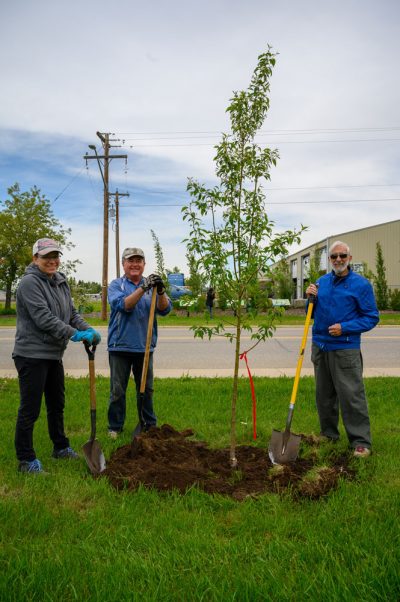Volunteers work to improve birth forest
By Sean Feagan, Local Journalism Initiative Reporter

Sean Feagan Photo
Strathmore is boasting new fruit and shrub trees after Strathmore Communities in Bloom completed another phase of its birth forest.
According to Rob Pirie, chairman of Strathmore Communities in Bloom (CIB), the organization’s birth forest in town is an effort to honour new residents while providing a food source.
“Each tree is to commemorate a baby born in the Strathmore area,” said Pirie. “We’ve been planting for many, many years now; 45 trees each year.”
Strathmore CIB is a chapter of the Canada-wide non-profit organization that works to foster civic pride and environmental responsibility through community involvement.
In 2017, Strathmore’s CIB birth forest planting moved to an area just north of Centennial Dr. east of Thomas Dr., said Pirie. The group decided to start planting all fruit trees and shrubs to give residents something to harvest each year.
“We started planting fruit trees with the idea that they would be a sustainable food source for people in Strathmore,” he said. “The public is welcome to come and take whatever they want.”
Strathmore CIB undertook its 2020 birth forest planting on June 6. This year, the work was done by members of CIB, along with some town staff and volunteers.
Chinook Financial provided funds for the trees, while Eagle Lake Nursery provided the trees and shrubs “at a great deal,” said Pirie. The Town of Strathmore supplies the land for the plantings.
The national CIB organization conducts evaluations of the contributions of participating communities each year. In 2018, Strathmore received five blooms, the highest possible ranking. As a prize, it was awarded five trees that were planted on the south side of Centennial Dr. during the June 6 event.
“These five trees commemorate the fact that Strathmore received five blooms for the first time in its (CIB) history,” said Pirie.
The local CIB chapter has worked to improve many of Strathmore’s green spaces, including Gray’s Park, Centennial Park and the Station Garden, said Pirie.
The organization helped create the Garden of Eat’n, a community garden plot located at the Hope Community Covenant Church. The project started as an 11-plot community garden located where the Anglican church is, explained organizer Robert Breitwieser. But when that church property sold, the garden beds were moved to Hope Church. More plots have been added, with a total of 16 there now.
Water for the garden is collected from the church roof via a large container that was donated by Tyson Plumbing.
People rent the garden plots for $20 and receive $10 back in the fall if they maintain it and clean it up at the end of the year. However, unlike the birth garden, only the hardworking gardeners are supposed to harvest food.
“The people who rent the beds are the ones who take the produce,” said Breitwieser. “It’s not for the whole community to come and help themselves.”
Breitwieser added the Garden of Eat’n has had problems with vandalism over the years, with “people just pulling stuff up and throwing it on the side.”
